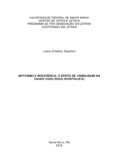| dc.creator | Giachini, Liana Cristina | |
| dc.date.accessioned | 2019-05-09T17:53:14Z | |
| dc.date.available | 2019-05-09T17:53:14Z | |
| dc.date.issued | 2018-12-17 | |
| dc.identifier.uri | http://repositorio.ufsm.br/handle/1/16507 | |
| dc.description.abstract | Within this thesis, located in the study field French Discourse Analysis, grounded by Michel Pêcheux and developed in Brazil by Eni Orlandi, we have aimed at understanding the discourse functioning of the urban artistic interventions promoted by the group Coletivo ARtivista Estopô Balaio in Jardim Romano neighborhood, São Paulo City. To do so, we have taken as discursiveness the play “A cidade dos Rios Invisíveis”, by Coletivo ARtivista Estopô Balaio, itinerant spectacle that circulates on the railway lines of Paulista de Trens Metropolitanos (CTPM) Incorporation, through which we have verified the production of the effect of (in)visibility of the subject living in the neighborhood Jardim Romano and the way they mean and are signified in/by urban space. In this gesture of interpretation, we understand the city as a meaningful space, where subjects, social practices, relations between the individual and society acquire material form, as a result of the symbolization of the relation between citizen space and the subjects who inhabit it, who also exist and mean. Our gesture of comprehension took part from the construction of discourse scenes composed by cutouts of the play that build the corpus of the thesis, in which meaning regularities emerge that form nets of repeatability. Our question relies on understanding how the group Coletivo Estopô Balaio moves itself in certain urban narrative, producing meaning effects of presence in the glide of (in)visibility. We highlight, to be short, that, via authorship effect, Coletivo produces in the play an effect of presence of subject-resident in the neighborhood, in the attempt to ensure visibility to such marginal subject. Jardim Romano neighborhood – at the same time scenario and character of the narrative – is constituted as threshold zone: in the space of marginal space, as river and city border, the migrant subject-body, nowadays inhabitant of Jardim Romano signifies by the lack, that is, has its right to the city denied by the absence of material conditions to urban access and (r)exists via Estopô Balaio art. | eng |
| dc.language | por | por |
| dc.publisher | Universidade Federal de Santa Maria | por |
| dc.rights | Attribution-NonCommercial-NoDerivatives 4.0 International | * |
| dc.rights.uri | http://creativecommons.org/licenses/by-nc-nd/4.0/ | * |
| dc.subject | ARtivismo | por |
| dc.subject | Efeito de autoria | por |
| dc.subject | Efeito de visibilidade | por |
| dc.subject | Resistência | por |
| dc.subject | Cidade | por |
| dc.subject | Artivism | eng |
| dc.subject | Effect of authorship | eng |
| dc.subject | Effect of visibility | eng |
| dc.subject | Resistance | eng |
| dc.title | ARtivismo e resistência: o efeito de visibilidade na cidade do(s) rio(s) invisível(eis) | por |
| dc.title.alternative | ARtivism and resitance: the effect of visbility in the city of invisible river(s) | eng |
| dc.type | Tese | por |
| dc.description.resumo | Nesta tese, situada no âmbito dos estudos da Análise de Discurso Francesa, cunhada por Michel Pêcheux e desenvolvida no Brasil por Eni Orlandi, objetivamos compreender o funcionamento discursivo das intervenções artísticas urbanas promovidas pelo Coletivo ARtivista Estopô Balaio junto ao Bairro Jardim Romano, na cidade de São Paulo. Para tanto, tomamos como discursividade a peça “A cidade dos Rios Invisíveis”, de autoria do próprio Coletivo, espetáculo itinerante que circula pelas linhas férreas da Companhia Paulista de Trens Metropolitanos (CTPM), na qual investigamos a produção do efeito de (in)visibilidade do sujeito morador do bairro Jardim Romano e a forma como ele significa e é significado no/pelo espaço urbano. Neste gesto de interpretação, entendemos a cidade como espaço significativo, no qual sujeitos, práticas sociais, relações entre o indivíduo e a sociedade adquirem forma material, como resultado da simbolização da relação entre o espaço citadino e os sujeitos que nele habitam, existem e se significam. Nosso gesto de leitura se deu a partir da construção de cenas discursivas compostas por recortes da peça que constitui o corpus desta tese, nos quais emergem regularidades que formam redes de repetibilidade. Nossa questão reside em compreender como o Coletivo Estopô Balaio se movimenta em uma dada narratividade urbana, produzindo efeitos de sentido de presença no deslizar da (in)visibilidade. Destacamos, resumidamente, que, por meio do efeito de autoria, o Coletivo produz na peça um efeito de presença do sujeito-morador do Bairro, na tentativa de conferir visibilidade a esse sujeito marginal. O Bairro Jardim Romano – ao mesmo tempo cenário e personagem nessa narrativa – se constitui como zona limiar: no espaço de marginalidade espacial, como margem do rio e margem da cidade, o sujeito-corpo migrante, agora habitante do Jardim Romano significa pela falta, ou seja, tem seu direito à cidade negado pela ausência de condições materiais de acesso ao urbano e (r)existe por meio da arte do Estopô Balaio. | por |
| dc.contributor.advisor1 | Scherer, Amanda Eloina | |
| dc.contributor.advisor1Lattes | http://lattes.cnpq.br/0683532681929143 | por |
| dc.contributor.referee1 | Sousa, Lucília Maria Abrahão e | |
| dc.contributor.referee1Lattes | http://lattes.cnpq.br/8828821460772801 | por |
| dc.contributor.referee2 | Garcia, Dantielli Assumpção | |
| dc.contributor.referee2Lattes | http://lattes.cnpq.br/4595437339696603 | por |
| dc.contributor.referee3 | Surdi, Mary Neiva | |
| dc.contributor.referee3Lattes | http://lattes.cnpq.br/8562922102534041 | por |
| dc.contributor.referee4 | Sturza, Eliana Rosa | |
| dc.contributor.referee4Lattes | http://lattes.cnpq.br/6356872087811361 | por |
| dc.creator.Lattes | http://lattes.cnpq.br/9045230868551888 | por |
| dc.publisher.country | Brasil | por |
| dc.publisher.department | Letras | por |
| dc.publisher.initials | UFSM | por |
| dc.publisher.program | Programa de Pós-Graduação em Letras | por |
| dc.subject.cnpq | CNPQ::LINGUISTICA, LETRAS E ARTES::LETRAS | por |
| dc.publisher.unidade | Centro de Artes e Letras | por |



